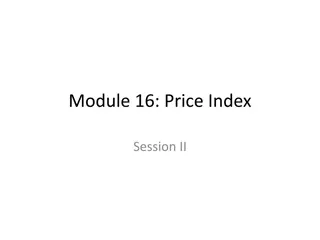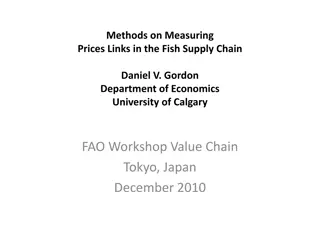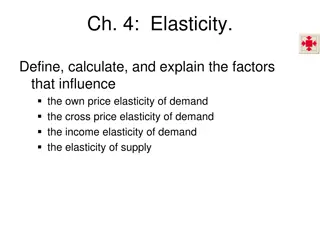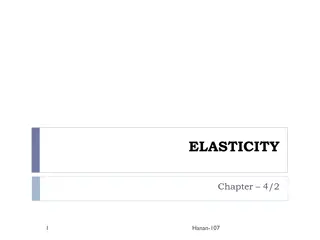Understanding Price Elasticity of Supply in Economics
Price elasticity of supply measures how much the quantity supplied responds to changes in price. It can be inelastic (quantity supplied responds slightly), elastic (quantity supplied responds substantially), or unit-elastic (price elasticity of supply equals 1). Various determinants like the passage of time, type of industry, availability of inputs, existing capacity, and inventories held impact the price elasticity of supply. Inelastic supply is when the price elasticity is less than 1, while elastic supply is when it's greater than 1. Examples and illustrations help clarify these concepts in real-world scenarios.
Download Presentation

Please find below an Image/Link to download the presentation.
The content on the website is provided AS IS for your information and personal use only. It may not be sold, licensed, or shared on other websites without obtaining consent from the author. Download presentation by click this link. If you encounter any issues during the download, it is possible that the publisher has removed the file from their server.
E N D
Presentation Transcript
Price Elasticity of Supply The law of supply states that higher prices raise the quantity supplied. The price elasticity of supply measures how much the quantity supplied responds to changes in the price.
Price Elasticity of Supply Since supply curves are upward sloping, the price elasticity of supply will be a positive number. Using Averages
Inelastic Supply Supply is said to be inelastic if the quantity supplied responds only slightly to changes in the price. If the price elasticity of supply is less than 1, then supply is inelastic. For example, the supply of many agricultural products in Australia is price inelastic, particularly for time periods of two years or less. If we assume that the price of beef increases by 10 per cent and in response the quantity supplied increases by 2 per cent, then: Price elasticity of supply = 2%/10% = 0.2 We can conclude that the supply of beef in Australia is inelastic.
Elastic Supply Supply of a good is said to be elastic if the quantity supplied responds substantially to changes in the price. If the price elasticity of supply is greater than 1, then supply is elastic. Example If the price of petrol increases before the weekend or a holiday period, the quantity supplied by petrol service stations is likely to be price elastic, as they are likely to have fuel in storage tanks or can order further deliveries of fuel from the refineries in a relatively short period of time.
Unit Elastic Supply If the price elasticity of supply is equal to 1, then supply is unit-elastic.
Determinants of the Price Elasticity of Supply Passage of time Type of industry Availability of inputs Existing capacity Inventories held
Determinants of the Price Elasticity of Supply Passage of Time Firms often have difficulty increasing the quantity of the product they supply during any short period of time. Example A pizza parlour cannot produce more pizzas on any one night than is possible using the ingredients on hand although within a day or two it can buy more ingredients, and within a few months it can hire more cooks and install additional ovens.
Determinants of the Price Elasticity of Supply Example A mining company cannot immediately increase the quantity of minerals supplied, because its ability to do so depends on whether: it is fully utilising existing equipment, it can hire the necessary labour or, in the longer term, exploration can discover more minerals. As a result, the supply curve for most products will tend to be relatively inelastic if we measure it over a short period of time and, in the example of minerals, perhaps much longer.
Determinants of the Price Elasticity of Supply Type of Industry Closely related to the time period involved is the type of industry. The characteristics of some industries enable them to change the quantity supplied quite quickly, while for other industries this is not possible. Example The quantity of agricultural products that can be supplied cannot be changed quickly because crops take time to grow and animals take time to breed, whereas some manufacturing industries may be able to increase the quantity supplied relatively quickly by operating machinery for additional hours.
Determinants of the Price Elasticity of Supply Availability of Inputs Some goods and services require resources that are themselves in fixed supply. The price elasticity of supply tends to be large when inputs are readily available and can be shifted into and out of production at a relatively low cost. It tends to be small when inputs are difficult to obtain and can be shifted into and out of production only at a relatively high cost. Example In the case of ambulance services, the high cost of providing quality ambulance services is the crucial element in keeping the elasticity of supply very low.
Determinants of the Price Elasticity of Supply In some industries it takes many years to train workers, such as: over six years for doctors, and skilled migration can take years. Supply in these industries will be price inelastic, particularly over the short to medium term. If skilled labour shortages exist, as has often been the case in Australia, or important raw materials become increasingly scarce, firms will be faced with steeply rising input and production costs as they attempt to increase their output levels. This will reduce their willingness and/or ability to increase the quantity supplied even if output prices rise.
Determinants of the Price Elasticity of Supply Existing Capacity If a firm has excess production capacity machines that could be operated for a longer period of time then the quantity supplied may be able to be changed quite quickly, and supply is therefore price elastic. Example Car manufacturers commonly increase or decrease the number of hours their production line machinery operates for, according to increases or decreases in consumer demand. In contrast, a mining company that is already operating at full capacity will not be able to increase supply for many years, as this will involve: o exploration, o acquiring legal permits, o raising finance, and o setting up the mining operation.
Determinants of the Price Elasticity of Supply Inventories Held Holding inventories is costly, as this involves storage premises and keeping stock that is currently not generating revenue from sales. Furthermore, some firms and industries are able to hold inventories stocks in reserve while others cannot. Supermarkets hold stocks in warehouses enabling them to refill store shelves quickly if sales suddenly increase. But if the demand for perishable items such fresh lettuces and carrots unexpectedly rose, these are not products that can be kept in storage for very long, and a quick supply response is not likely.























